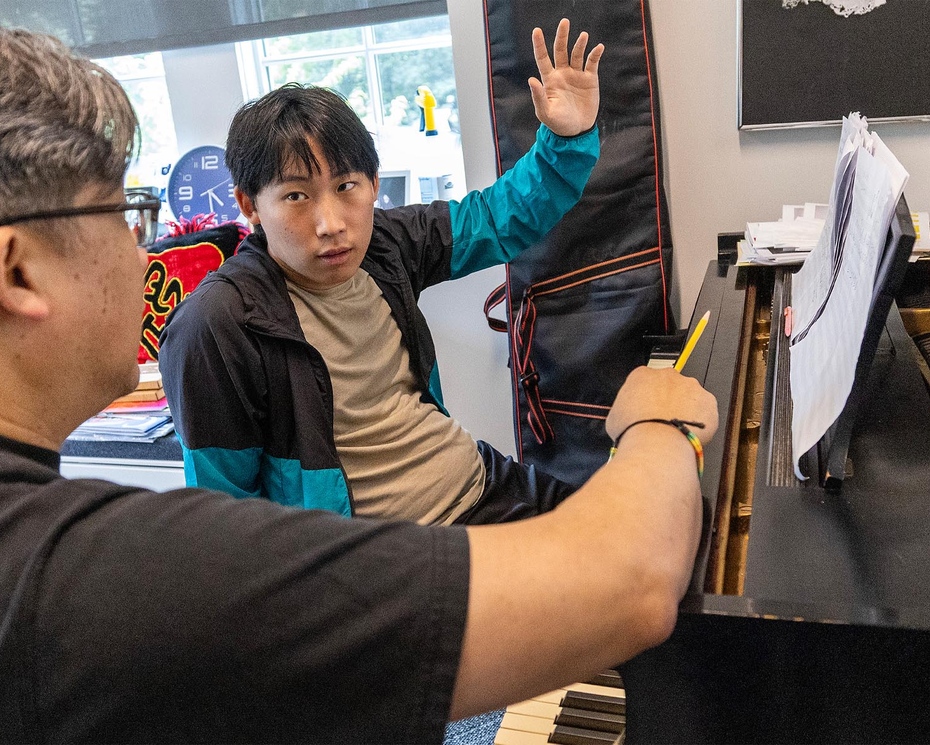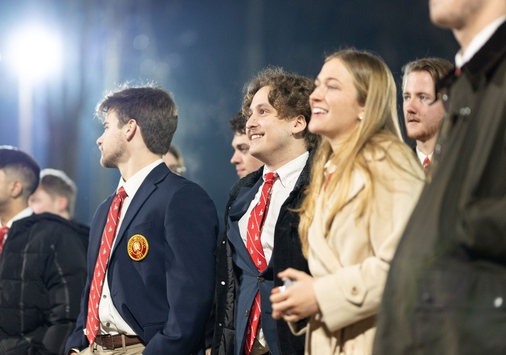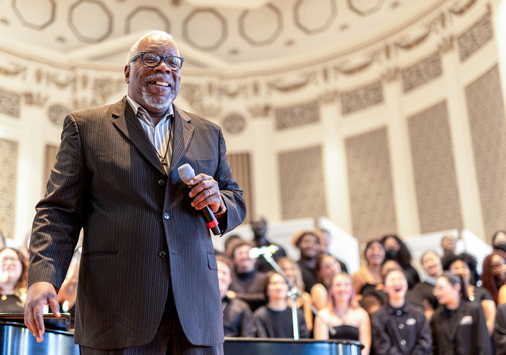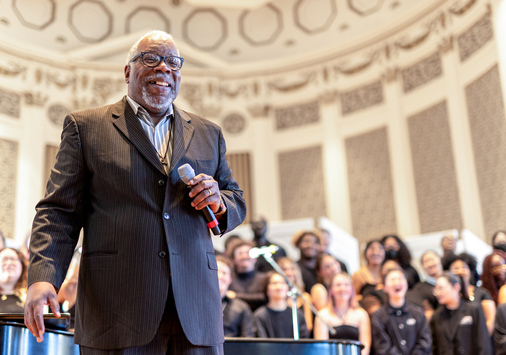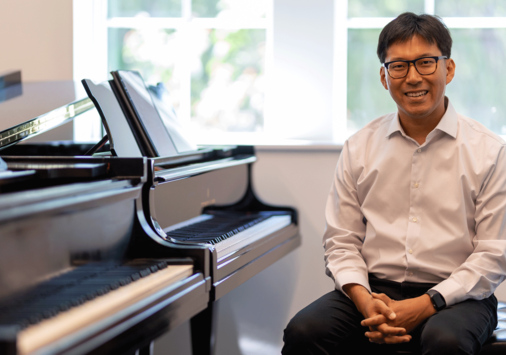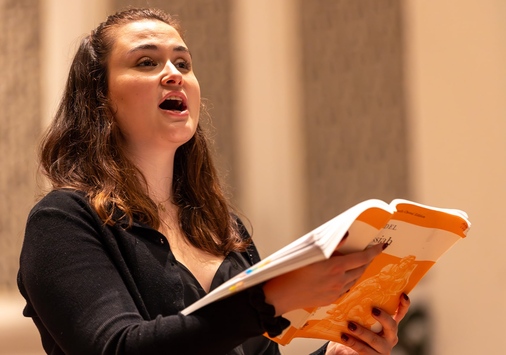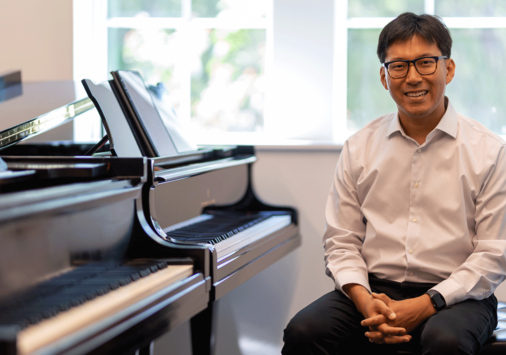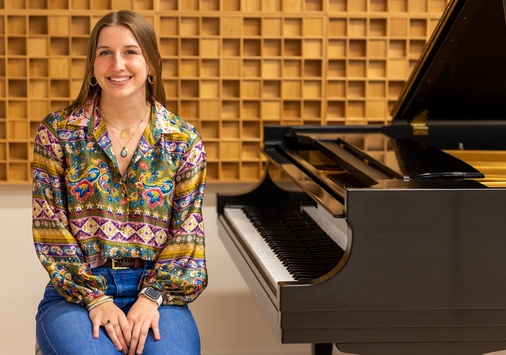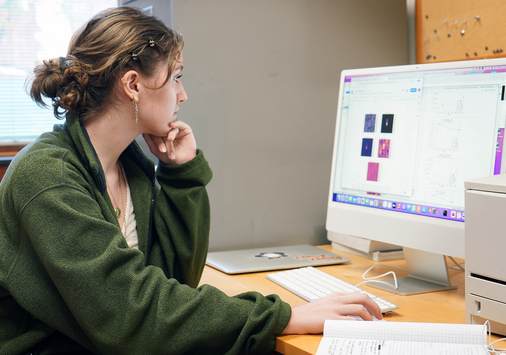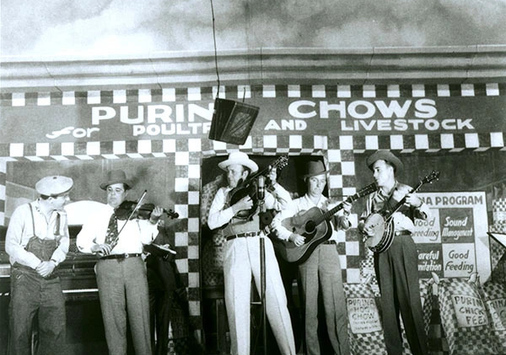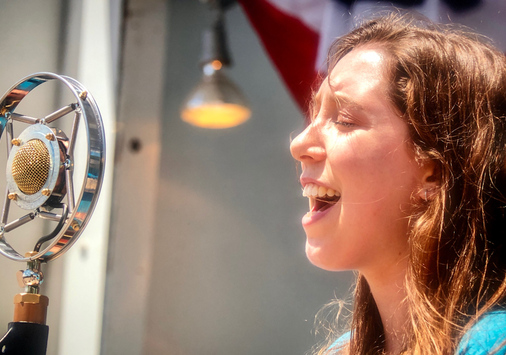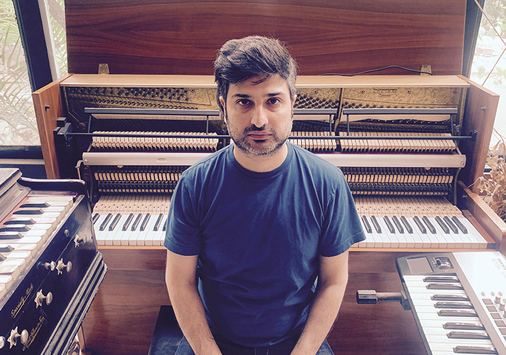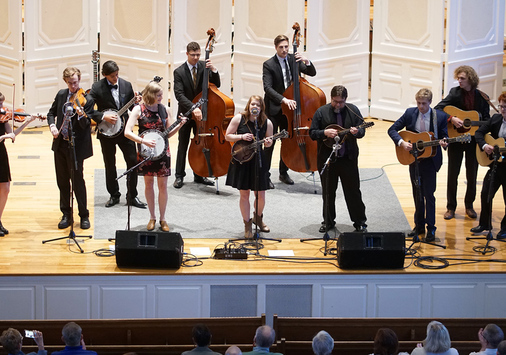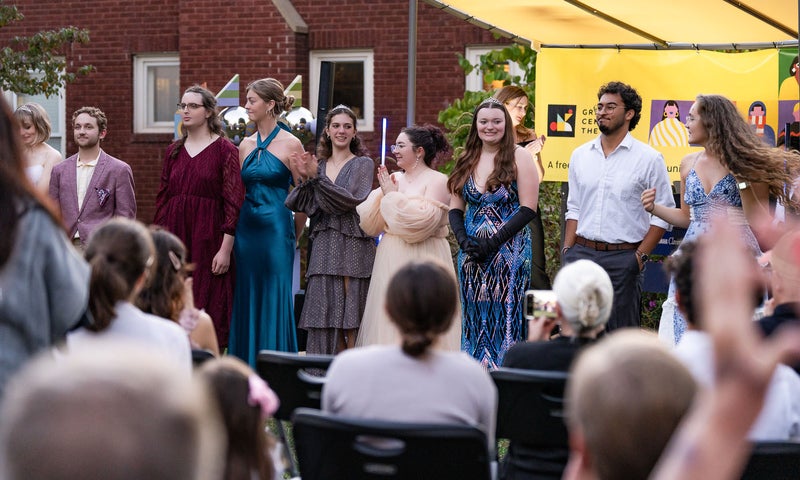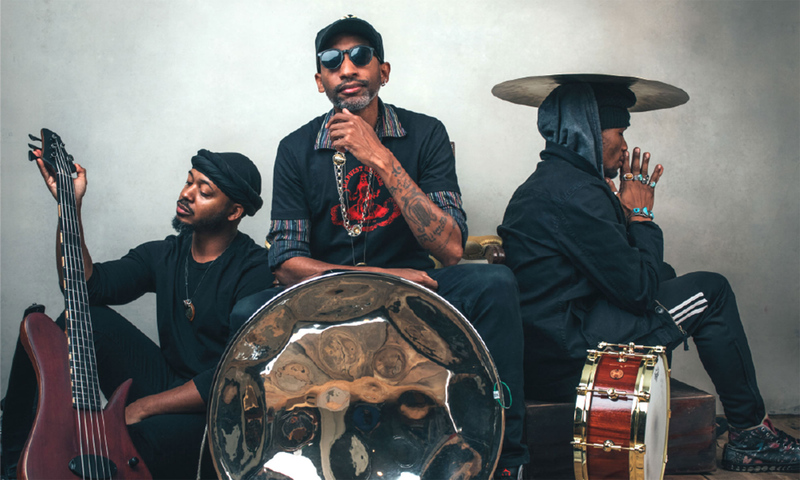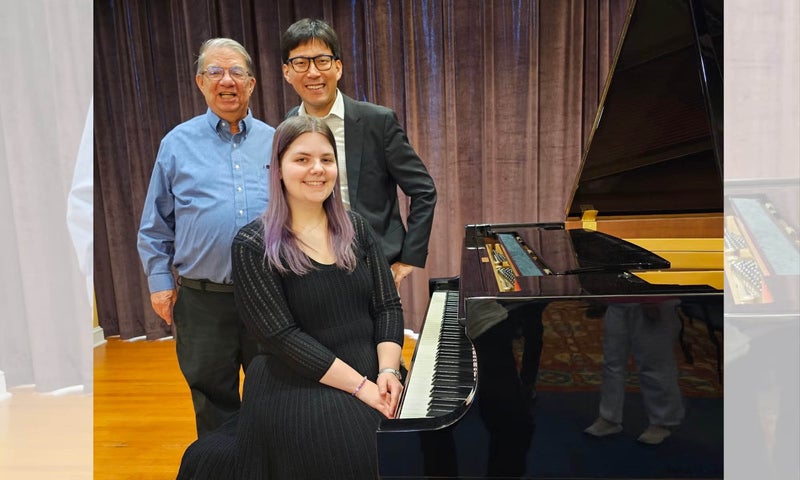Courses
2025 - 2026
For this academic year's course catalog, please visit our Academic Catalog site. For courses currently offered, please refer to the Schedule of Classes.
All music majors must enroll in and pass the Keyboard Proficiency and Performance Skills Exam or complete MUSP 127 - Keyboard Skills I and MUSP 128 - Keyboard Skills II.
All music majors must enroll in and pass the Keyboard Proficiency and Performance Skills Exam or complete MUSP 127 - Keyboard Skills I and MUSP 128 - Keyboard Skills II.
This course is an overview of western "art" music from the Middle Ages to present day. Emphasis is placed on the forms and styles of music categorized by historical periods and the composers' social environment. Extensive music listening is incorporated into the curriculum both in class and as assignments. The ability to read musical notation is not required.
This course will introduce students to the uniquely American art form Jazz, through a study of the musical contributions of its major figures. The course of study will include all styles of jazz, from early jazz (Dixieland) to the music of today.
This course explores different approaches to music-making throughout the world by examining the ritual and social contexts, compositional techniques, performance styles, instruments, and learning traditions of different musical cultures. The course begins with an overview of musical terminology and ethnomusicological methodologies that can be applied to various types of global music (including World/Country and World/Bluegrass). Subsequently, the course builds on this foundational knowledge by examining various case studies from around the world and comparing them to Western classical and popular traditions.
This course seeks to explain the basic foundations of musical construction. The universal elements of pitch, rhythm, and harmony will be uncovered along with musical contexts across varied and diverse styles. Students will also explore their own musical intuitions by learning to use basic recording software. No previous musical experience is necessary.
This course explores the history and craft of video game music from the first synthesized sound effects that accompanied early arcade machines to modern orchestral compositions. Students will survey soundtracks, composers, and compositional techniques that were employed along with.
Recommended for beginners in guitar. Stresses fundamentals of picking, strumming and note reading.
For intermediate guitar students with basic skills. Emphasis on guitar styles and improvisation.
Prerequisite(s): MUS 112 or consent.
The third course in the guitar sequence.
Prerequisite(s): MUS 113 or consent.
An introduction to vocal techniques and pedagogy.
The Alexander Technique is a widely recognized educational method for improving balance, alignment, ease, flexibility and energy. The Technique offers us insight into the underlying principles that govern human movement. When applied, these principles guide us to a dynamic kinesthetic lightness, wherein thinking becomes clearer, feeling accessible, sensations livelier, and movement more pleasurable. Within this fluid, more conscious condition, we find our actions and interactions strengthened and refined, our sense of time expanded, and our rapport with the environment restored. The workshop addresses structural problems treated by performing arts medicine and in addition, neuroscience research which supports evidence of misuse resulting in pain/injury by our own mental process and perceptions of our body's structure. We explore gentle movement and relaxation exercise as well as the application of Body Mapping to gain clear and accurate information about our anatomical structure for optimal movement.
A general category used only in the evaluation of transfer credit.
Fundamentals of written musical materials including terminology, tuning systems, notation, intervals, scales, chords, basic diatonic harmony, rhythm, simple forms, aural skills and computer music applications.
A historical survey of art music in Western Europe from the Medieval era through 1800. Across the survey, students will learn about the evolution of musical style, political and social contexts, and the development of notation, printing, and performance practices. Assessment includes unit and final exams, short writing assignments and analyses, and discussions of readings. Understanding of musical notation is required.
A historical survey of art music in Western Europe and the United States from 1800 through the present. Across the survey, students will learn about the evolution of musical style, political and social contexts, economic structures, and the impact of folk, popular, and non-Western music. Assessment includes unit and final exams, short writing assignments and analyses, and discussions of readings. Understanding of musical notation is required.
Prerequisite(s): MUS 200.
Beethoven’s symphonies are among the most famous works in the canon of Western classical music and are revolutionary in their conveyance of musical (and some would argue extra-musical) narrative within the symphonic genre. This class explores the idea of narrative and how it is heard in his music through a focused study of the symphonies and overtures written between 1803-1812. The course approaches this topic through reflective and research writing. The ability to read musical notation is required.
A survey of approaches to musical harmony including linear systems (counterpoint), vertical systems (common practice tonality, polytonality), mathematical systems (serialism) and jazz systems.
Prerequisite(s): MUS 200.
An introduction to conducting and orchestration. Students will compose, orchestrate and conduct original works of music.
Prerequisite(s): MUS 205.
The Mass Ordinary is the cornerstone of the eucharistic ritual of the Roman Catholic Church. This course traces the development of western art music through landmark musical settings of the Mass Ordinary. Composers studied include Josquin des Prez, Palestrina, J. S. Bach, F. J. Haydn, Ludwig van Beethoven, Leonard Bernstein, and others. Students will learn about historical events, technological advancements, and socio-political trends that led to changes in ritualistic practices and the music that accompanied them. For music majors, this course is designed to help solidify and contextualize foundational knowledge of western musical history and terminology. For non-music majors, this course will serve as an introductory survey of western sacred musical literature, from the earliest forms of notation and chant through landmark compositions from each of the major musical eras.
A survey of music-making in America from the colonial period to the present, including early American sacred, patriotic, and political music; musical theatre; and various popular and art music genres of the 19th and 20th centuries, particularly as influenced by the collision between European and African musical traditions. The ability to read musical notation is not required.
Broadway musical might seem like toe-tapping, tourist-trapping escapism. But many musicals have used comedy, music, dance and fantasies to issue serious social commentary for audiences. This course will examine a variety of shows from the 1940s through the present, considering both the development and evolution of musical/dramatic conventions and examining shows through lenses of gender, race, exoticism, and historiography to better understand the cultural work these shows have performed in American history. Students will study a show in depth each week and conduct their own research on a show of their choosing.
A study of audio recording focusing on acoustics, microphone techniques, live and studio recording techniques, editing, signal processing and production.
An introduction to creating music with a computer, focusing on sequencing, sampling and direct synthesis.
A consideration of the increasingly complex behavior of music in the modern (or postmodern) world. We will pay particular attention to the function of music: its uses, the ways in which it is part of - and helps to define - daily life for a number of diverse populations in a number of diverse locales, and the ways in which it is transmitted in a global culture. The ability to read musical notation is not required.
Historically, women have played an integral role in musical traditions around the world, although the extent of their contributions has only recently been recognized and studied in an academic context. This course traces the development and current state of women's roles in music, including Western art music composers, performers, critics, and teachers; performers of popular American genres such as jazz, country, and rock; and performers of popular "World Beat" and traditional world musics.
Crosslisting: WGST 220.
This course explores the graphical programming language of Max/MSP. Through collaboration and invention, we will explore the interaction of coding and signal processing to build custom synthesizers, manipulate samples, and consider current systems of music creation. This course focuses on digital synthesis, modulations, sonic morphologies, and contemporary composition practices. The ability to read musical notation is not required.
An exploration of topics in computer music relating to improvisation and live-performance using inter-active programs.
In this course, we will look at the development of Western Art music from the end of the Renaissance period through the careers of J.S. Bach and G.F. Handel, covering an approximate period of 1600-1750. Understanding of musical notation is required.
A study of 19th-century Western art music, focusing on the genres of art song, piano music, symphonic music, chamber music, and opera, from late Beethoven to Debussy. Works will be considered in their historical and cultural context, as well as from the point of view of their musical characteristics. Understanding of musical notation is required.
This course provides a more in-depth look into some of the myriad styles, social movements, and aesthetic debates that have shaped the pluralistic music making in the twentieth century. Topics to be explored may include the role of technology, musical borrowing, social and political movements, intersections with other art forms, and changes to musical institutions. Students will be expected to lead and participate in discussions of primary texts and academic scholarship, to listen and analyze key works, and to conduct their own research on a topic of interest related to the course. Completion of Music History II may provide some helpful background, but is not required. Understanding of musical notation is required.
This course examines the musical styles and cultural significance of country and folk musics in the United States, tracing its development from oral traditions through the present day. Primary sources, reviews and critical scholarship provide context for songs. This course touches upon several themes throughout the semester, including technological changes in the country music industry, political uses of country music, definitions of genre, and gender, class, and racial identities of artists and fans.
This course will explore the historical development of African-American gospel music in the 20th Century. The course will begin an examination of the pre-gospel era (pre-1900s-ca. 1920), move on to gospel music's beginnings (ca. 1920s), and continue unto the present. The course will explore the musical, sociological, political, and religious influences that contributed to the development of the various gospel music eras and styles. Through class lectures, demonstrations, music listening, reading and writing assignments, students will learn about the significant musical and non-musical contributions of African American gospel artists and the historical development of African American gospel music. Students will also strive to gain an understanding of the African American musical aesthetic and to determine how it is retained and expressed with African American gospel music and other musical genres. The class is open to students, staff, and faculty of all levels.
Latin American music is incredibly diverse in its historical musical elements, and in turn, is some of the most influential source material of popular music today. The course will focus on several main regions of development each with a central organizing nation: Cuba and the Caribbean, Mexico and Central America, and Brazil and South America. Along with aural analysis of the music itself, focus will be paid to the unique social construction of the prevailing musical styles for each region. The course will culminate with the development of Latin American music in the United States and its influence on modern popular music.
This course attempts to answer the question, “What is Bluegrass Music?” For some the answer appears to be very clear and for others it is very elusive. We will look at the origins and influences and try to pinpoint the moment it came to exist. Who created it? Who developed it? Who continues to influence it? What instruments and sounds are involved and which are out of bounds? We will also attempt to define what it is not. By taking a broad look at American Roots Music from the 20th century, putting Bluegrass music at the center, we will discover the various influences of American acoustic music and better understand its progression into modern times. Throughout the course we will also find that the origins of Bluegrass music are actually very diverse. Along with the impact of European music, we will look at the role that women and African Americans play in the development of bluegrass, old time, early country and American Roots Music in general.
Top ten musical artists of all time—go! Chances are you’ve thought about who would go on your list, who’s overrated, and why some things that are terrible somehow become popular. This course will encourage you to think about the hows and whys of musical tastes. Over the term, we’ll consider the cultural messages put forth when certain kinds of music are lauded or dismissed, the cultural barriers artists face to becoming part of the canon, and just how these public and personal tastes are formed and change over time. Our course will emphasize a melding of data collection and analysis and cultural theory that allow us to contextualize our findings.
This class explores a diversity of movements within rock music from the 1950s through the present. Central to this class is the music itself. Thus one key focus is on building a working knowledge of the musical language of rock (including elements of melody, harmony, rhythm, texture, form, style). In addition, this is a class is historiography where we will investigate how history is created and contested through primary texts such as musicians memoirs and journalistic music criticism. Through these readings, we will discuss rock's relationship to its historical, cultural, and social context, paying particular attention to issues of race, class, gender, and sexuality in postwar US culture. The ability to read musical notation is not required.
This course considers the role music has played in uniting people around social and political change. In particular, this course considers the music of protest movements in the US from the 19th century to the present. By examining the music of several protest movements, students will consider music as a tool of artists and groups used to reclaim a given space or song in order to fight injustice. The ability to read musical notation is not necessary in this course.
Special Topics in Music Performance is a course offering that deals with various aspects of performance within music.
Special Topics in Musicology/Music History is a course offering that deals with music with respects to its history, people, and culture.
Special Ensemble in Music Theory is a course offering that deals with the musicianship aspects of Music Theory and Aural Skills.
Special Topics in Music Collaborations are courses that do not fall within the other designations and are collaborative in nature. They may be courses within the department or in collaboration with other Denison departments.
Whether in a business meeting, competing in a sporting event, or in a test-taking situation, performance is often a crucial aspect of success in a variety of domains. Because the careers of performing artists (musicians, dancers, actors, etc.) hinge on successful performance, those artists spend a great deal of energy learning how to harness their own capacities. Not only do performing artists spend practice time training muscles, but they also practice mental strategies that allow for optimal performance under pressure. The purpose of this course is to look at effective mental strategies used by performing artists with the tools afforded to us by research in social psychology. In doing so, we will take the psychological strategies of artists and link them with performance situations in other domains. Work in this class will include readings from relevant psychology research, performing artist narratives, and hands-on, participatory practice techniques.
This course explores how music has been utilized to construct identity in America from the nineteenth century to today. Within the broad themes of race, ethnicity, gender, and queerness, we look at how groups and individuals use music to represent themselves and others. The course covers an array of song, stage, and screen traditions and relies on primary sources, critical scholarship, and audio-visual materials to bring our subjects to life. Although our course makes no attempt at a comprehensive history of any one tradition, it nevertheless demonstrates through a series of historical snapshots how music has served as a powerful tool for representing ourselves and others, no matter how contradictory, incomplete, or intersectional those identities may be. The ability to read musical notation is not required.
This course examines the rich history and evolution of hip-hop culture from the South Bronx to its present global reach. Throughout the semester, we will learn to analyze songs and music videos by considering the changing aesthetic and political dimensions of their creation and consumption. We will pay particular attention to themes of race, class, gender, and sexuality and consider how these elements have forged intersectional systems of oppression that were foundational to the genre’s origins as well as its present moment. The ability to read music notation is not required but a willingness to engage with difficult topics is.
Music, Society, and Identity explores fundamental questions about music and its role in our lives: What is music? How does it communicate to listeners? How does music play a role in social and political behavior? How does music shape our identities? Students will engage in hands-on exploration and discussion of these questions, working collaboratively to ask and answer questions about music. Musical examples are drawn from across the globe and across history to demonstrate that music is neither universal nor fixed, with attention given to music and issues of the 21st century so students may better understand the place of music in their world.
Crosslisting: WGST 285.
Movements in Global Music examines music and its function in cultures around the world. Moving through a series of case studies, the course investigates the sounds, settings, and significances of different musical traditions while paying close attention to themes of mobility, movement, and meaning. In addition to these major themes, the course regularly touches on topics of race, religion, gender, politics, and resistance. Through hands-on activities and in-class demonstrations, students will gain deeper understandings of music traditions from across the globe. As we learn about the cultures of others, we will turn our attention to our own, applying our growing vocabulary to the various traditions to which we belong. No knowledge of music notation is required.
A general category used only in the evaluation of transfer credit.
The Junior Recital is a 30 to 40 minute solo performance of appropriate concert literature selected in consultation with the private lesson instructor. Must be taken concurrently with Private Lessons.
Beethoven’s symphonies are among the most famous works in the canon of Western classical music and are revolutionary in their conveyance of musical (and some would argue extra-musical) narrative within the symphonic genre. This class explores the idea of narrative and how it is heard in his music through a focused study of the symphonies and overtures written between 1803-1812. The course approaches this topic through reflective and research writing. The ability to read musical notation is required.
Prerequisite(s): MUS 104.
Music Theory Three will apply and synthesize the skills and knowledge developed in the music theory sequence in order to develop and defend ideas about the music from their performance repertoire. Students will use what they've learned to ask bigger questions, devise and justify their own analytical viewpoint, and to hypothesize approaches to interpreting music that is beyond their own experience. Topics will include chromatic harmony, linear analysis, modality, form, post-tonal approaches, and research.
Prerequisite(s): MUS 205.
The Mass Ordinary is the cornerstone of the eucharistic ritual of the Roman Catholic Church. This course traces the development of western art music through landmark musical settings of the Mass Ordinary. Composers studied include Josquin des Prez, Palestrina, J. S. Bach, F. J. Haydn, Ludwig van Beethoven, Leonard Bernstein, and others. Students will learn about historical events, technological advancements, and socio-political trends that led to changes in ritualistic practices and the music that accompanied them. For music majors, this course is designed to help solidify and contextualize foundational knowledge of western musical history and terminology. For non-music majors, this course will serve as an introductory survey of western sacred musical literature, from the earliest forms of notation and chant through landmark compositions from each of the major musical eras.
A survey of music-making in America from the colonial period to the present, including early American sacred, patriotic, and political music; musical theatre; and various popular and art music genres of the 19th and 20th centuries, particularly as influenced by the collision between European and African musical traditions. The ability to read musical notation is not required.
Broadway musical might seem like toe-tapping, tourist-trapping escapism. But many musicals have used comedy, music, dance and fantasies to issue serious social commentary for audiences. This course will examine a variety of shows from the 1940s through the present, considering both the development and evolution of musical/dramatic conventions and examining sows through lenses of gender, race, exocitism, and historiography to better understand the cultural work these shows have performed in American History. Students will study a show in depth each week and conduct their own research on a show of their choosing.
A consideration of the increasingly complex behavior of music in the modern (or postmodern) world. We will pay particular attention to the function of music: its uses, the ways in which it is part of - and helps to define - daily life for a number of diverse populations in a number of diverse locales, and the ways in which it is transmitted in a global culture. The ability to read musical notation is not required.
Historically, women have played an integral role in musical traditions around the world, although the extent of their contributions has only recently been recognized and studied in an academic context. This course will trace the development and current state of women's roles in music, including Western art music composers, performers, critics, and teachers; performers of popular American genres such as jazz, country, and rock; and performers of popular "World Beat" and traditional world musics.
In this course, we will look at the development of Western Art music from the end of the Renaissance period through the careers of J.S. Bach and G.F. Handel, covering an approximate period of 1600-1750. Understanding of musical notation is required.
A study of 19th-century Western art music, focusing on the genres of art song, piano music, symphonic music, chamber music, and opera, from late Beethoven to Debussy. Works will be considered in their historical and cultural context, as well as from the point of view of their musical characteristics. Understanding of musical notation is required.
This course provides a more in-depth look into some of the myriad styles, social movements, and aesthetic debates that have shaped the pluralistic music making in the twentieth century. Topics to be explored may include the role of technology, musical borrowing, social and political movements, intersections with other art forms, and changes to musical institutions. Students will be expected to lead and participate in discussions of primary texts and academic scholarship, to listen and analyze key works, and to conduct their own research on a topic of interest related to the course. Completion of Music History II may provide some helpful background, but is not required. Understanding of musical notation is required.
This course examines the musical styles and cultural significance of country and folk musics in the United States, tracing its development from oral traditions through the present day. Primary sources, reviews and critical scholarship provide context for songs. This course touches upon several themes throughout the semester, including technological changes in the country music industry, political uses of country music, definitions of genre, and gender, class, and racial identities of artists and fans.
This course will explore the use of music and sound in Western cinema, from the Classical Hollywood era of the 1940s to the present. Careful attention will be given to developing analysis, research, and writing skills. Students will be expected to complete several original analyses of scenes, culminating in an original research paper analyzing a film or films of the student’s choice. Weekly readings and viewings will be required.
Considers the impact of a composer's or other musical artist's gender and sexual orientation on his or her creative output by addressing questions such as: Is there such a thing as a queer aesthetic or sensibility in music? What, if anything, do gender or sexual orientation have to do with musicality? Do the gender or sexual orientation of a composer or musical artist matter to listeners? What impact does a musical artist's gender or sexual orientation have on his or her ability to get his or her music performed? And how have the answers to these questions changed over time?
Crosslisting: QS 332 and WGST 332.
This course will explore the historical development of African-American gospel music in the 20th Century. The course will began an examination of the pre-gospel era (pre-1900's-ca 1920), move on to gospel music's beginnings (ca. 1920's), and continue onto the present. The course will explore the musical sociological, political and religious influences that contributed to the development of the various gospel music eras and styles. Through class lectures, demonstrations, music listening, reading and writing assignments, students will learn about the significant musical and non-musical contributions of African American gospel artists and the historical development of African American gospel music. Students will also strive to gain an understanding of the African American musical aesthetic and to determine how it is retained and expressed with African American gospel music and other musical genres. The class is open to students, staff and faculty of all levels.
Latin American music is incredibly diverse in its historical components, and in turn, is some of the most influential source material of popular music today. The course focuses on several main regions of development each with specific countries of influence: Cuba, Puerto Rico, Dominican Republic and the Caribbean; Mexico and North/Central America; and Brazil and South America. Along with aural analysis of the music itself, the course analyzes the unique social construction of the prevailing musical styles for each region. The themes of cultural interaction and collision along with (often forced) population shifts provide a uniting current across the vast geography of study and provide organizing through-line across the region. If time permits, the course will culminate with the development of Latin American music in the United States and its influence on modern popular music.
This course attempts to answer the question, “What is Bluegrass Music?” For some the answer appears to be very clear and for others it is very elusive. We will look at the origins and influences and try to pinpoint the moment it came to exist. Who created it? Who developed it? Who continues to influence it? What instruments and sounds are involved and which are out of bounds? We will also attempt to define what it is not. By taking a broad look at American Roots Music from the 20th century, putting Bluegrass music at the center, we will discover the various influences of American acoustic music and better understand its progression into modern times. Throughout the course we will also find that the origins of Bluegrass music are actually very diverse. Along with the impact of European music, we will look at the role that women and African Americans play in the development of bluegrass, old time, early country and American Roots Music in general.
Top ten musical artists of all time—go! Chances are you’ve thought about who would go on your list, who’s overrated, and why some things that are terrible somehow become popular. This course will encourage you to think about the hows and whys of musical tastes. Over the term, we’ll consider the cultural messages put forth when certain kinds of music are lauded or dismissed, the cultural barriers artists face to becoming part of the canon, and just how these public and personal tastes are formed and change over time. Our course will emphasize a melding of data collection and analysis and cultural theory that allow us to contextualize our findings.
This class explores a diversity of movements within rock music from the 1950s through the present. Central to this class is the music itself. Thus one key focus is on building a working knowledge of the musical language of rock (including elements of melody, harmony, rhythm, texture, form, style). In addition, this is a class is historiography where we will investigate how history is created and contested through primary texts such as musicians memoirs and journalistic music criticism. Through these readings, we will discuss rock's relationship to its historical, cultural, and social context, paying particular attention to issues of race, class, gender, and sexuality in postwar US culture. The ability to read musical notation is not required.
Special Topics in Music Performance is a course offering that deals with various aspects of performance within music.
Special Topics in Musicology/Music History is a course offering that deals with music with respects to its history, people, and culture.
Special Ensemble in Music Theory is a course offering that deals with the musicianship aspects of Music Theory and Aural Skills.
A student in good standing may work intensively in areas of special interest under the Directed Study plan. A Directed Study is appropriate when, under the guidance of a faculty member, a student wants to explore a subject more fully than is possible in a regular course or to study a subject not covered in the regular curriculum. A Directed Study should not normally duplicate a course that is regularly offered. Directed Studies are normally taken for 3 or 4 credits. A one-semester Directed Study is limited to a maximum of 4 credit hours. Note: Directed Studies may not be used to fulfill General Education requirements.
A student in good standing may work intensively in areas of special interest under the Directed Study plan. A Directed Study is appropriate when, under the guidance of a faculty member, a student wants to explore a subject more fully than is possible in a regular course or to study a subject not covered in the regular curriculum. A Directed Study should not normally duplicate a course that is regularly offered. Directed Studies are normally taken for 3 or 4 credits. A one-semester Directed Study is limited to a maximum of 4 credit hours. Note: Directed Studies may not be used to fulfill General Education requirements.
Independent Study engages a student in the pursuit of clearly defined goals. In this effort, a student may employ skills and information developed in previous course experiences or may develop some mastery of new knowledge or skills. A proposal for an Independent Study project must be approved in advance by the faculty member who agrees to serve as the project advisor. Note: Independent Studies may not be used to fulfill General Education requirements.
Independent Study engages a student in the pursuit of clearly defined goals. In this effort, a student may employ skills and information developed in previous course experiences or may develop some mastery of new knowledge or skills. A proposal for an Independent Study project must be approved in advance by the faculty member who agrees to serve as the project advisor. Note: Independent Studies may not be used to fulfill General Education requirements.
A general category used only in the evaluation of transfer credit.
The Senior Recital is a 50 to 60 minute solo performance of appropriate concert literature selected in consultation with the private lesson instructor. Must be taken concurrently with Private Lessons.
The Senior Project is a composition or research project in the emphasis of the music major (composition, computer music or music history) to be selected and completed in consultation with the appropriate area instructor.
Students may enroll in Senior Research in their final year at Denison. Normally, Senior Research requires a major thesis, report, or project in the student's field of concentration and carries eight semester-hours of credit for the year. Typically, a final grade for a year-long Senior Research will not be assigned until the completion of the year-long Senior Research at the end of the second semester. Each semester of Senior Research is limited to a maximum of 4 credit hours. Note: Senior Research may not be used to fulfill General Education requirements.
Students may enroll in Senior Research in their final year at Denison. Normally, Senior Research requires a major thesis, report, or project in the student's field of concentration and carries eight semester-hours of credit for the year. Typically, a final grade for a year-long Senior Research will not be assigned until the completion of the year-long Senior Research at the end of the second semester. Each semester of Senior Research is limited to a maximum of 4 credit hours. Note: Senior Research may not be used to fulfill General Education requirements.
Offered for beginning piano students, the piano class will focus on fundamental piano technique and score reading, as well as the playing of lead sheets. Students will work on individual electronic pianos, both solo and in groups.
This is designed for non-music majors with no significant background in piano who would like to continue their piano studies. This course is a continuation of Piano Class I (MUSP 111) curriculum. Students will explore the joy of making music through more advanced (late beginning/early intermediate level) repertoire. Other emphasis is placed upon ensemble work (duet, trio, quartet), chord progressions, harmonization, and sight-reading.
A once weekly (50-minute) performance-oriented course open to instrumentalists. The major objective is to gain an in-depth working knowledge of improvisation in the jazz context. Pre-requisites include the ability to play an instrument and a working knowledge of major scales, or permission of the instructor. The class meeting time is TBA and the instructor will work towards a schedule that works for everyone signed up.
This ensemble course is designed for piano students who are looking for an ensemble credit. Students will be assigned a vocal or instrumental partner. Students are responsible for regularly rehearsing with their partners (one hour weekly rehearsals are required), attending their partners’ lessons as needed, and performing with them in recitals, masterclasses, and juries.
Prerequisite(s): Approval of the instructor.
American Roots Seminar looks closely at the formulas for arranging American Roots Music including bluegrass, blues, old-time string band, Appalachian Fiddle and early country music. Based on our understanding and data collected from the song formulas, students compose vocal songs and instrumental songs reflecting traditional composition styles and topics. Students are assigned parts to compose and will collaborate to develop the components and arrangement of each song: form, chord progression, melody, harmony, lyric writing and instrumental elements including solos, intros and ornamentation. This course is required for students seeking a Bachelor of Arts degree in music with an emphasis in American Roots Music.
A sequence for the music major, minor, and performance certificate student to fulfill the keyboard proficiency in the Department of Music. Other students may enroll with the permission of the instructor.
A sequence for the music major, minor, and performance certificate student to fulfill the keyboard proficiency in the Department of Music. Other students may enroll with permission of the instructor.
A seminar approach to musical composition focusing on individual composition projects, compositional processes, forms, aesthetics and criticism. May be repeated for credit.
The Denison University Orchestra welcomes players with diverse musical interests and from a wide array of majors. Drawing from a broad range of canonical string orchestra and symphonic repertoire, as well as newly composed works, the orchestra offers students a top-level orchestral experience and serves an important role in representing Denison University in the community. Frequent off-campus tours, along with regular collaborations with guest artists, faculty, and other Denison ensembles, continue to enrich and expand the legacy of the ensemble.
The Denison University Concert Choir is a long-established community/university choir that includes singers from the Granville area, as well as Denison faculty, staff, and students who are interested in performing major choral works and other works of interest. A placement audition is required, but no prior choral experience is necessary.
The Denison Music Theatre Workshop is for students who sing and enjoy performing on stage. Once a semester, the students in the class will present a fully staged opera, operetta, or musical theatre production. Class literature ranges from Broadway musicals to light operas. All students are welcome, but solos are chosen by audition.
The Denison University Gospel Choir carries the tradition of sharing love and hope through song to our community. We learn and perform songs in the true African American gospel tradition, as well as some that are contemporary and inspiring.
Crosslisting: BLST 133.
The Denison University Jazz Ensemble performs music ranging from the traditional big band era to contemporary jazz. Audition required.
The Denison University American Roots Music Ensemble is dedicated to the multi-genre and multicultural music developed in the US during the 19th, 20th, and 21st centuries. This broad term represents “folk” or “traditional” music such as Bluegrass, Appalachian, and African-American string band/fiddle music, Gospel music, and the blues, as well as contemporary music derived from these traditions. Each semester, students in the ensemble explore a different area of this music, learning about the fundamentals of American Roots Music while working on original arrangements. Pre-approved instruments include guitar, mandolin, violin/fiddle, bass, slide guitar/”dobro,” cello, and banjo. Additional instruments will be accepted with the approval of the Director.
Denison University Chamber Singers is a select mixed choral ensemble that performs an array of musical styles, including Renaissance polyphony, contemporary works, vocal jazz arrangements, folk songs, and spirituals. The required audition consists of vocal exercises, sight-singing, and a pitch retention/general musical knowledge assessment. A prepared solo is optional.
Gamelan Ensemble is a traditional Balinese Angklung Gamelan, Indonesia's classical percussion ensemble. It is open to all Denison students as well as community members, requires no previous experience, and meets once weekly for an evening rehearsal.
The African-American Roots Ensemble.
Jazz Combo is a small ensemble open to any instrumentalists and vocalists. Traditional jazz is the focus, along with the music of Brazil, funk, and contemporary jazz and pop.
Pedagogical and performance skills will be developed through laboratory and observational experiences. Includes Flute Ensemble, Oboe Ensemble, Clarinet Ensemble, Bassoon Ensemble, Woodwind Chamber Music, and Saxophone Chamber Music.
Students enrolled in Brass Ensemble will receive 13 rehearsals and one concert each semester. Each rehearsal will total 50 minutes and will be scheduled at a mutually convenient time for the professor and students.
Latin Jazz is a small improvising ensemble concentrating on music from Latin and Pan-African origins. Open to rhythm section and horn players, along with percussionists.
This ensemble focuses on performances by a small group of musicians, with one player per instrumental part, and often includes piano alongside other instruments like strings or winds. Denison encourages students to participate in various ensembles, including the Piano Chamber Music ensemble, as part of their liberal arts philosophy.
An introduction to string techniques and pedagogy.
Guitar Ensemble is a group that rehearses and performs on acoustic guitars, developing arrangements of jazz, pop, blues, and classical music repertoire. Improvisation techniques are also discussed. Performance experience is not required.
Chamber music is a form of classical music that is composed for a small group of instruments—traditionally a group that could fit in a palace chamber or a large room. Usually, groups are of 3-10 players and self-conducted. Chamber music creates independence and camaraderie simultaneously. Listening to each other, matching music-making ideas of colors, bow strokes, vibrato, and dynamics is a wonderful way to develop as a musician and to support other musicians. Some describe chamber music as “the music of friends.” Knowledge of how to play your instrument and use the bow is required. Private lessons are highly recommended with the professor of your chosen instrument.
A small chamber ensemble dedicated to performance of percussion literature. Meets weekly TBA, with a performance each term.
Is the primary ensemble for all winds, brass, and percussion students. The repertoire of the ensemble reflects the breadth of wind literature and includes music from the late Renaissance to world premieres. The ensemble frequently collaborates with other ensembles on campus (recent examples include Chamber Singers and Jazz Ensemble). Students are expected to commit to membership in Wind Ensemble for a full academic year as our concert preparation spans semesters. Students wishing to join Orchestra must also enroll in Wind Ensemble. Dr. Chris David Westover, conductor. Membership by audition.
Students enrolled in Private Lessons should also be concurrently enrolled in an ensemble. The minimum number of required lessons must be taken on the same instrument (or voice). There is an applied music fee for each academic credit hour. For costs, see Department of Music Fees in the Annual Costs section of the catalog. All declared Music Majors receive two waived credits (three with chair's permission) for private lesson instruction each semester; Performance Minors receive two waived credits, and General Minors receive one waived credit. Beginning students should opt for the class lessons in class piano, class voice, and class guitar. There is no extra fee for class lessons. Students who drop private lessons after the drop date will still be responsible for their lesson fee. One credit hour is given for one half-hour lesson per week, and students are expected to practice one hour daily.
Students enrolled in Private Lessons should also be concurrently enrolled in an ensemble. The minimum number of required lessons must be taken on the same instrument (or voice). There is an applied music fee for each academic credit hour. For costs, see Department of Music Fees in the Annual Costs section of the catalog. All declared Music Majors receive two waived credits (three with chair's permission) for private lesson instruction each semester; Performance Minors receive two waived credits, and General Minors receive one waived credit. Beginning students should opt for the class lessons in class piano, class voice, and class guitar. There is no extra fee for class lessons. Students who drop private lessons after the drop date will still be responsible for their lesson fee. One credit hour is given for one half-hour lesson per week, and students are expected to practice one hour daily.
Students enrolled in Private Lessons should also be concurrently enrolled in an ensemble. The minimum number of required lessons must be taken on the same instrument (or voice). There is an applied music fee for each academic credit hour. For costs, see Department of Music Fees in the Annual Costs section of the catalog. All declared Music Majors receive two waived credits (three with chair's permission) for private lesson instruction each semester; Performance Minors receive two waived credits, and General Minors receive one waived credit. Beginning students should opt for the class lessons in class piano, class voice, and class guitar. There is no extra fee for class lessons. Students who drop private lessons after the drop date will still be responsible for their lesson fee. One credit hour is given for one half-hour lesson per week, and students are expected to practice one hour daily.
Students enrolled in Private Lessons should also be concurrently enrolled in an ensemble. The minimum number of required lessons must be taken on the same instrument (or voice). There is an applied music fee for each academic credit hour. For costs, see Department of Music Fees in the Annual Costs section of the catalog. All declared Music Majors receive two waived credits (three with chair's permission) for private lesson instruction each semester; Performance Minors receive two waived credits, and General Minors receive one waived credit. Beginning students should opt for the class lessons in class piano, class voice, and class guitar. There is no extra fee for class lessons. Students who drop private lessons after the drop date will still be responsible for their lesson fee. One credit hour is given for one half-hour lesson per week, and students are expected to practice one hour daily.
Students enrolled in Private Lessons should also be concurrently enrolled in an ensemble. The minimum number of required lessons must be taken on the same instrument (or voice). There is an applied music fee for each academic credit hour. For costs, see Department of Music Fees in the Annual Costs section of the catalog. All declared Music Majors receive two waived credits (three with chair's permission) for private lesson instruction each semester; Performance Minors receive two waived credits, and General Minors receive one waived credit. Beginning students should opt for the class lessons in class piano, class voice, and class guitar. There is no extra fee for class lessons. Students who drop private lessons after the drop date will still be responsible for their lesson fee. One credit hour is given for one half-hour lesson per week, and students are expected to practice one hour daily.
Students enrolled in Private Lessons should also be concurrently enrolled in an ensemble. The minimum number of required lessons must be taken on the same instrument (or voice). There is an applied music fee for each academic credit hour. For costs, see Department of Music Fees in the Annual Costs section of the catalog. All declared Music Majors receive two waived credits (three with chair's permission) for private lesson instruction each semester; Performance Minors receive two waived credits, and General Minors receive one waived credit. Beginning students should opt for the class lessons in class piano, class voice, and class guitar. There is no extra fee for class lessons. Students who drop private lessons after the drop date will still be responsible for their lesson fee. One credit hour is given for one half-hour lesson per week, and students are expected to practice one hour daily.
Students enrolled in Private Lessons should also be concurrently enrolled in an ensemble. The minimum number of required lessons must be taken on the same instrument (or voice). There is an applied music fee for each academic credit hour. For costs, see Department of Music Fees in the Annual Costs section of the catalog. All declared Music Majors receive two waived credits (three with chair's permission) for private lesson instruction each semester; Performance Minors receive two waived credits, and General Minors receive one waived credit. Beginning students should opt for the class lessons in class piano, class voice, and class guitar. There is no extra fee for class lessons. Students who drop private lessons after the drop date will still be responsible for their lesson fee. One credit hour is given for one half-hour lesson per week, and students are expected to practice one hour daily.
Students enrolled in Private Lessons should also be concurrently enrolled in an ensemble. The minimum number of required lessons must be taken on the same instrument (or voice). There is an applied music fee for each academic credit hour. For costs, see Department of Music Fees in the Annual Costs section of the catalog. All declared Music Majors receive two waived credits (three with chair's permission) for private lesson instruction each semester; Performance Minors receive two waived credits, and General Minors receive one waived credit. Beginning students should opt for the class lessons in class piano, class voice, and class guitar. There is no extra fee for class lessons. Students who drop private lessons after the drop date will still be responsible for their lesson fee. One credit hour is given for one half-hour lesson per week, and students are expected to practice one hour daily.
A once weekly (50-minute) performance-oriented course open to instrumentalists. The major objective is to gain an in-depth working knowledge of improvisation in the jazz context. Pre-requisites include the ability to play an instrument and a working knowledge of major scales, or permission of the instructor. The class meeting time is TBA, and the instructor will work towards a schedule that works for everyone signed up.
Students enrolled in Private Lessons should also be concurrently enrolled in an ensemble. The minimum number of required lessons must be taken on the same instrument (or voice). There is an applied music fee for each academic credit hour. For costs, see Department of Music Fees in the Annual Costs section of the catalog. All declared Music Majors receive two waived credits (three with chair's permission) for private lesson instruction each semester; Performance Minors receive two waived credits, and General Minors receive one waived credit. Beginning students should opt for the class lessons in class piano, class voice, and class guitar. There is no extra fee for class lessons. Students who drop private lessons after the drop date will still be responsible for their lesson fee. One credit hour is given for one half-hour lesson per week, and students are expected to practice one hour daily.
Students enrolled in Private Lessons should also be concurrently enrolled in an ensemble. The minimum number of required lessons must be taken on the same instrument (or voice). There is an applied music fee for each academic credit hour. For costs, see Department of Music Fees in the Annual Costs section of the catalog. All declared Music Majors receive two waived credits (three with chair's permission) for private lesson instruction each semester; Performance Minors receive two waived credits, and General Minors receive one waived credit. Beginning students should opt for the class lessons in class piano, class voice, and class guitar. There is no extra fee for class lessons. Students who drop private lessons after the drop date will still be responsible for their lesson fee. One credit hour is given for one half-hour lesson per week, and students are expected to practice one hour daily.
Students enrolled in Private Lessons should also be concurrently enrolled in an ensemble. The minimum number of required lessons must be taken on the same instrument (or voice). There is an applied music fee for each academic credit hour. For costs, see Department of Music Fees in the Annual Costs section of the catalog. All declared Music Majors receive two waived credits (three with chair's permission) for private lesson instruction each semester; Performance Minors receive two waived credits, and General Minors receive one waived credit. Beginning students should opt for the class lessons in class piano, class voice, and class guitar. There is no extra fee for class lessons. Students who drop private lessons after the drop date will still be responsible for their lesson fee. One credit hour is given for one half-hour lesson per week, and students are expected to practice one hour daily.
Students enrolled in Private Lessons should also be concurrently enrolled in an ensemble. The minimum number of required lessons must be taken on the same instrument (or voice). There is an applied music fee for each academic credit hour. For costs, see Department of Music Fees in the Annual Costs section of the catalog. All declared Music Majors receive two waived credits (three with chair's permission) for private lesson instruction each semester; Performance Minors receive two waived credits, and General Minors receive one waived credit. Beginning students should opt for the class lessons in class piano, class voice, and class guitar. There is no extra fee for class lessons. Students who drop private lessons after the drop date will still be responsible for their lesson fee. One credit hour is given for one half-hour lesson per week, and students are expected to practice one hour daily.
Students enrolled in Private Lessons should also be concurrently enrolled in an ensemble. The minimum number of required lessons must be taken on the same instrument (or voice). There is an applied music fee for each academic credit hour. For costs, see Department of Music Fees in the Annual Costs section of the catalog. All declared Music Majors receive two waived credits (three with chair's permission) for private lesson instruction each semester; Performance Minors receive two waived credits, and General Minors receive one waived credit. Beginning students should opt for the class lessons in class piano, class voice, and class guitar. There is no extra fee for class lessons. Students who drop private lessons after the drop date will still be responsible for their lesson fee. One credit hour is given for one half-hour lesson per week, and students are expected to practice one hour daily.
Students enrolled in Private Lessons should also be concurrently enrolled in an ensemble. The minimum number of required lessons must be taken on the same instrument (or voice). There is an applied music fee for each academic credit hour. For costs, see Department of Music Fees in the Annual Costs section of the catalog. All declared Music Majors receive two waived credits (three with chair's permission) for private lesson instruction each semester; Performance Minors receive two waived credits, and General Minors receive one waived credit. Beginning students should opt for the class lessons in class piano, class voice, and class guitar. There is no extra fee for class lessons. Students who drop private lessons after the drop date will still be responsible for their lesson fee. One credit hour is given for one half-hour lesson per week, and students are expected to practice one hour daily.
Students enrolled in Private Lessons should also be concurrently enrolled in an ensemble. The minimum number of required lessons must be taken on the same instrument (or voice). There is an applied music fee for each academic credit hour. For costs, see Department of Music Fees in the Annual Costs section of the catalog. All declared Music Majors receive two waived credits (three with chair's permission) for private lesson instruction each semester; Performance Minors receive two waived credits, and General Minors receive one waived credit. Beginning students should opt for the class lessons in class piano, class voice, and class guitar. There is no extra fee for class lessons. Students who drop private lessons after the drop date will still be responsible for their lesson fee. One credit hour is given for one half-hour lesson per week, and students are expected to practice one hour daily.
Students enrolled in Private Lessons should also be concurrently enrolled in an ensemble. The minimum number of required lessons must be taken on the same instrument (or voice). There is an applied music fee for each academic credit hour. For costs, see Department of Music Fees in the Annual Costs section of the catalog. All declared Music Majors receive two waived credits (three with chair's permission) for private lesson instruction each semester; Performance Minors receive two waived credits, and General Minors receive one waived credit. Beginning students should opt for the class lessons in class piano, class voice, and class guitar. There is no extra fee for class lessons. Students who drop private lessons after the drop date will still be responsible for their lesson fee. One credit hour is given for one half-hour lesson per week, and students are expected to practice one hour daily.
Students enrolled in Private Lessons should also be concurrently enrolled in an ensemble. The minimum number of required lessons must be taken on the same instrument (or voice). There is an applied music fee for each academic credit hour. For costs, see Department of Music Fees in the Annual Costs section of the catalog. All declared Music Majors receive two waived credits (three with chair's permission) for private lesson instruction each semester; Performance Minors receive two waived credits, and General Minors receive one waived credit. Beginning students should opt for the class lessons in class piano, class voice, and class guitar. There is no extra fee for class lessons. Students who drop private lessons after the drop date will still be responsible for their lesson fee. One credit hour is given for one half-hour lesson per week, and students are expected to practice one hour daily.
Students enrolled in Private Lessons should also be concurrently enrolled in an ensemble. The minimum number of required lessons must be taken on the same instrument (or voice). There is an applied music fee for each academic credit hour. For costs, see Department of Music Fees in the Annual Costs section of the catalog. All declared Music Majors receive two waived credits (three with chair's permission) for private lesson instruction each semester; Performance Minors receive two waived credits, and General Minors receive one waived credit. Beginning students should opt for the class lessons in class piano, class voice, and class guitar. There is no extra fee for class lessons. Students who drop private lessons after the drop date will still be responsible for their lesson fee. One credit hour is given for one half-hour lesson per week, and students are expected to practice one hour daily.
Students enrolled in Private Lessons should also be concurrently enrolled in an ensemble. The minimum number of required lessons must be taken on the same instrument (or voice). There is an applied music fee for each academic credit hour. For costs, see Department of Music Fees in the Annual Costs section of the catalog. All declared Music Majors receive two waived credits (three with chair's permission) for private lesson instruction each semester; Performance Minors receive two waived credits, and General Minors receive one waived credit. Beginning students should opt for the class lessons in class piano, class voice, and class guitar. There is no extra fee for class lessons. Students who drop private lessons after the drop date will still be responsible for their lesson fee. One credit hour is given for one half-hour lesson per week, and students are expected to practice one hour daily.
Students enrolled in Private Lessons should also be concurrently enrolled in an ensemble. The minimum number of required lessons must be taken on the same instrument (or voice). There is an applied music fee for each academic credit hour. For costs, see Department of Music Fees in the Annual Costs section of the catalog. All declared Music Majors receive two waived credits (three with chair's permission) for private lesson instruction each semester; Performance Minors receive two waived credits, and General Minors receive one waived credit. Beginning students should opt for the class lessons in class piano, class voice, and class guitar. There is no extra fee for class lessons. Students who drop private lessons after the drop date will still be responsible for their lesson fee. One credit hour is given for one half-hour lesson per week, and students are expected to practice one hour daily.
Students enrolled in Private Lessons should also be concurrently enrolled in an ensemble. The minimum number of required lessons must be taken on the same instrument (or voice). There is an applied music fee for each academic credit hour. For costs, see Department of Music Fees in the Annual Costs section of the catalog. All declared Music Majors receive two waived credits (three with chair's permission) for private lesson instruction each semester; Performance Minors receive two waived credits, and General Minors receive one waived credit. Beginning students should opt for the class lessons in class piano, class voice, and class guitar. There is no extra fee for class lessons. Students who drop private lessons after the drop date will still be responsible for their lesson fee. One credit hour is given for one half-hour lesson per week, and students are expected to practice one hour daily.
Students enrolled in Private Lessons should also be concurrently enrolled in an ensemble. The minimum number of required lessons must be taken on the same instrument (or voice). There is an applied music fee for each academic credit hour. For costs, see Department of Music Fees in the Annual Costs section of the catalog. All declared Music Majors receive two waived credits (three with chair's permission) for private lesson instruction each semester; Performance Minors receive two waived credits, and General Minors receive one waived credit. Beginning students should opt for the class lessons in class piano, class voice, and class guitar. There is no extra fee for class lessons. Students who drop private lessons after the drop date will still be responsible for their lesson fee. One credit hour is given for one half-hour lesson per week, and students are expected to practice one hour daily.
Students enrolled in Private Lessons should also be concurrently enrolled in an ensemble. The minimum number of required lessons must be taken on the same instrument (or voice). There is an applied music fee for each academic credit hour. For costs, see Department of Music Fees in the Annual Costs section of the catalog. All declared Music Majors receive two waived credits (three with chair's permission) for private lesson instruction each semester; Performance Minors receive two waived credits, and General Minors receive one waived credit. Beginning students should opt for the class lessons in class piano, class voice, and class guitar. There is no extra fee for class lessons. Students who drop private lessons after the drop date will still be responsible for their lesson fee. One credit hour is given for one half-hour lesson per week, and students are expected to practice one hour daily.
Students enrolled in Private Lessons should also be concurrently enrolled in an ensemble. The minimum number of required lessons must be taken on the same instrument (or voice). There is an applied music fee for each academic credit hour. For costs, see Department of Music Fees in the Annual Costs section of the catalog. All declared Music Majors receive two waived credits (three with chair's permission) for private lesson instruction each semester; Performance Minors receive two waived credits, and General Minors receive one waived credit. Beginning students should opt for the class lessons in class piano, class voice, and class guitar. There is no extra fee for class lessons. Students who drop private lessons after the drop date will still be responsible for their lesson fee. One credit hour is given for one half-hour lesson per week, and students are expected to practice one hour daily.
Special Ensemble in Music Performance is a course offering that deals with various aspects of performance within music.
Special Ensemble in Music Composition is a course offering that deals with the creative aspects of music composition.
Special Ensemble in Music Collaborations are courses that do not fall within the other designations in nature. They may be courses within the department or in collaboration with other Denison departments.
Music performance majors and performance minors must enroll for two-credit-hour lessons on their primary instrument; non-performance minors must enroll for one-credit-hour lessons. The minimum number of required lessons must be taken on the same instrument (or voice). Students enrolled in Private Lessons should also be concurrently enrolled in an ensemble. There is an applied music fee for each academic credit hour. For costs, see Department of Music Fees in the Annual Costs section of the catalog. All declared Music Majors receive two waived credits (three with chair's permission) for private lesson instruction each semester; Performance Minors receive two waived credits, and General Minors receive one waived credit. Beginning students should opt for the class lessons in class piano, class voice, and class guitar. There is no extra fee for class lessons. Students who drop private lessons after the drop date will still be responsible for their lesson fee. Two credit hours are given for one hour-long lesson per week, and students are expected to practice two hours daily.
Music performance majors and performance minors must enroll for two-credit-hour lessons on their primary instrument; non-performance minors must enroll for one-credit-hour lessons. The minimum number of required lessons must be taken on the same instrument (or voice). Students enrolled in Private Lessons should also be concurrently enrolled in an ensemble. There is an applied music fee for each academic credit hour. For costs, see Department of Music Fees in the Annual Costs section of the catalog. All declared Music Majors receive two waived credits (three with chair's permission) for private lesson instruction each semester; Performance Minors receive two waived credits, and General Minors receive one waived credit. Beginning students should opt for the class lessons in class piano, class voice, and class guitar. There is no extra fee for class lessons. Students who drop private lessons after the drop date will still be responsible for their lesson fee. Two credit hours are given for one hour-long lesson per week, and students are expected to practice two hours daily.
Music performance majors and performance minors must enroll for two-credit-hour lessons on their primary instrument; non-performance minors must enroll for one-credit-hour lessons. The minimum number of required lessons must be taken on the same instrument (or voice). Students enrolled in Private Lessons should also be concurrently enrolled in an ensemble. There is an applied music fee for each academic credit hour. For costs, see Department of Music Fees in the Annual Costs section of the catalog. All declared Music Majors receive two waived credits (three with chair's permission) for private lesson instruction each semester; Performance Minors receive two waived credits, and General Minors receive one waived credit. Beginning students should opt for the class lessons in class piano, class voice, and class guitar. There is no extra fee for class lessons. Students who drop private lessons after the drop date will still be responsible for their lesson fee. Two credit hours are given for one hour-long lesson per week, and students are expected to practice two hours daily.
Music performance majors and performance minors must enroll for two-credit-hour lessons on their primary instrument; non-performance minors must enroll for one-credit-hour lessons. The minimum number of required lessons must be taken on the same instrument (or voice). Students enrolled in Private Lessons should also be concurrently enrolled in an ensemble. There is an applied music fee for each academic credit hour. For costs, see Department of Music Fees in the Annual Costs section of the catalog. All declared Music Majors receive two waived credits (three with chair's permission) for private lesson instruction each semester; Performance Minors receive two waived credits, and General Minors receive one waived credit. Beginning students should opt for the class lessons in class piano, class voice, and class guitar. There is no extra fee for class lessons. Students who drop private lessons after the drop date will still be responsible for their lesson fee. Two credit hours are given for one hour-long lesson per week, and students are expected to practice two hours daily.
Music performance majors and performance minors must enroll for two-credit-hour lessons on their primary instrument; non-performance minors must enroll for one-credit-hour lessons. The minimum number of required lessons must be taken on the same instrument (or voice). Students enrolled in Private Lessons should also be concurrently enrolled in an ensemble. There is an applied music fee for each academic credit hour. For costs, see Department of Music Fees in the Annual Costs section of the catalog. All declared Music Majors receive two waived credits (three with chair's permission) for private lesson instruction each semester; Performance Minors receive two waived credits, and General Minors receive one waived credit. Beginning students should opt for the class lessons in class piano, class voice, and class guitar. There is no extra fee for class lessons. Students who drop private lessons after the drop date will still be responsible for their lesson fee. Two credit hours are given for one hour-long lesson per week, and students are expected to practice two hours daily.
Music performance majors and performance minors must enroll for two-credit-hour lessons on their primary instrument; non-performance minors must enroll for one-credit-hour lessons. The minimum number of required lessons must be taken on the same instrument (or voice). Students enrolled in Private Lessons should also be concurrently enrolled in an ensemble. There is an applied music fee for each academic credit hour. For costs, see Department of Music Fees in the Annual Costs section of the catalog. All declared Music Majors receive two waived credits (three with chair's permission) for private lesson instruction each semester; Performance Minors receive two waived credits, and General Minors receive one waived credit. Beginning students should opt for the class lessons in class piano, class voice, and class guitar. There is no extra fee for class lessons. Students who drop private lessons after the drop date will still be responsible for their lesson fee. Two credit hours are given for one hour-long lesson per week, and students are expected to practice two hours daily.
Music performance majors and performance minors must enroll for two-credit-hour lessons on their primary instrument; non-performance minors must enroll for one-credit-hour lessons. The minimum number of required lessons must be taken on the same instrument (or voice). Students enrolled in Private Lessons should also be concurrently enrolled in an ensemble. There is an applied music fee for each academic credit hour. For costs, see Department of Music Fees in the Annual Costs section of the catalog. All declared Music Majors receive two waived credits (three with chair's permission) for private lesson instruction each semester; Performance Minors receive two waived credits, and General Minors receive one waived credit. Beginning students should opt for the class lessons in class piano, class voice, and class guitar. There is no extra fee for class lessons. Students who drop private lessons after the drop date will still be responsible for their lesson fee. Two credit hours are given for one hour-long lesson per week, and students are expected to practice two hours daily.
Music performance majors and performance minors must enroll for two-credit-hour lessons on their primary instrument; non-performance minors must enroll for one-credit-hour lessons. The minimum number of required lessons must be taken on the same instrument (or voice). Students enrolled in Private Lessons should also be concurrently enrolled in an ensemble. There is an applied music fee for each academic credit hour. For costs, see Department of Music Fees in the Annual Costs section of the catalog. All declared Music Majors receive two waived credits (three with chair's permission) for private lesson instruction each semester; Performance Minors receive two waived credits, and General Minors receive one waived credit. Beginning students should opt for the class lessons in class piano, class voice, and class guitar. There is no extra fee for class lessons. Students who drop private lessons after the drop date will still be responsible for their lesson fee. Two credit hours are given for one hour-long lesson per week, and students are expected to practice two hours daily.
Music performance majors and performance minors must enroll for two-credit-hour lessons on their primary instrument; non-performance minors must enroll for one-credit-hour lessons. The minimum number of required lessons must be taken on the same instrument (or voice). Students enrolled in Private Lessons should also be concurrently enrolled in an ensemble. There is an applied music fee for each academic credit hour. For costs, see Department of Music Fees in the Annual Costs section of the catalog. All declared Music Majors receive two waived credits (three with chair's permission) for private lesson instruction each semester; Performance Minors receive two waived credits, and General Minors receive one waived credit. Beginning students should opt for the class lessons in class piano, class voice, and class guitar. There is no extra fee for class lessons. Students who drop private lessons after the drop date will still be responsible for their lesson fee. Two credit hours are given for one hour-long lesson per week, and students are expected to practice two hours daily.
Music performance majors and performance minors must enroll for two-credit-hour lessons on their primary instrument; non-performance minors must enroll for one-credit-hour lessons. The minimum number of required lessons must be taken on the same instrument (or voice). Students enrolled in Private Lessons should also be concurrently enrolled in an ensemble. There is an applied music fee for each academic credit hour. For costs, see Department of Music Fees in the Annual Costs section of the catalog. All declared Music Majors receive two waived credits (three with chair's permission) for private lesson instruction each semester; Performance Minors receive two waived credits, and General Minors receive one waived credit. Beginning students should opt for the class lessons in class piano, class voice, and class guitar. There is no extra fee for class lessons. Students who drop private lessons after the drop date will still be responsible for their lesson fee. Two credit hours are given for one hour-long lesson per week, and students are expected to practice two hours daily.
Music performance majors and performance minors must enroll for two-credit-hour lessons on their primary instrument; non-performance minors must enroll for one-credit-hour lessons. The minimum number of required lessons must be taken on the same instrument (or voice). Students enrolled in Private Lessons should also be concurrently enrolled in an ensemble. There is an applied music fee for each academic credit hour. For costs, see Department of Music Fees in the Annual Costs section of the catalog. All declared Music Majors receive two waived credits (three with chair's permission) for private lesson instruction each semester; Performance Minors receive two waived credits, and General Minors receive one waived credit. Beginning students should opt for the class lessons in class piano, class voice, and class guitar. There is no extra fee for class lessons. Students who drop private lessons after the drop date will still be responsible for their lesson fee. Two credit hours are given for one hour-long lesson per week, and students are expected to practice two hours daily.
Music performance majors and performance minors must enroll for two-credit-hour lessons on their primary instrument; non-performance minors must enroll for one-credit-hour lessons. The minimum number of required lessons must be taken on the same instrument (or voice). Students enrolled in Private Lessons should also be concurrently enrolled in an ensemble. There is an applied music fee for each academic credit hour. For costs, see Department of Music Fees in the Annual Costs section of the catalog. All declared Music Majors receive two waived credits (three with chair's permission) for private lesson instruction each semester; Performance Minors receive two waived credits, and General Minors receive one waived credit. Beginning students should opt for the class lessons in class piano, class voice, and class guitar. There is no extra fee for class lessons. Students who drop private lessons after the drop date will still be responsible for their lesson fee. Two credit hours are given for one hour-long lesson per week, and students are expected to practice two hours daily.
Music performance majors and performance minors must enroll for two-credit-hour lessons on their primary instrument; non-performance minors must enroll for one-credit-hour lessons. The minimum number of required lessons must be taken on the same instrument (or voice). Students enrolled in Private Lessons should also be concurrently enrolled in an ensemble. There is an applied music fee for each academic credit hour. For costs, see Department of Music Fees in the Annual Costs section of the catalog. All declared Music Majors receive two waived credits (three with chair's permission) for private lesson instruction each semester; Performance Minors receive two waived credits, and General Minors receive one waived credit. Beginning students should opt for the class lessons in class piano, class voice, and class guitar. There is no extra fee for class lessons. Students who drop private lessons after the drop date will still be responsible for their lesson fee. Two credit hours are given for one hour-long lesson per week, and students are expected to practice two hours daily.
Music performance majors and performance minors must enroll for two-credit-hour lessons on their primary instrument; non-performance minors must enroll for one-credit-hour lessons. The minimum number of required lessons must be taken on the same instrument (or voice). Students enrolled in Private Lessons should also be concurrently enrolled in an ensemble. There is an applied music fee for each academic credit hour. For costs, see Department of Music Fees in the Annual Costs section of the catalog. All declared Music Majors receive two waived credits (three with chair's permission) for private lesson instruction each semester; Performance Minors receive two waived credits, and General Minors receive one waived credit. Beginning students should opt for the class lessons in class piano, class voice, and class guitar. There is no extra fee for class lessons. Students who drop private lessons after the drop date will still be responsible for their lesson fee. Two credit hours are given for one hour-long lesson per week, and students are expected to practice two hours daily.
Music performance majors and performance minors must enroll for two-credit-hour lessons on their primary instrument; non-performance minors must enroll for one-credit-hour lessons. The minimum number of required lessons must be taken on the same instrument (or voice). Students enrolled in Private Lessons should also be concurrently enrolled in an ensemble. There is an applied music fee for each academic credit hour. For costs, see Department of Music Fees in the Annual Costs section of the catalog. All declared Music Majors receive two waived credits (three with chair's permission) for private lesson instruction each semester; Performance Minors receive two waived credits, and General Minors receive one waived credit. Beginning students should opt for the class lessons in class piano, class voice, and class guitar. There is no extra fee for class lessons. Students who drop private lessons after the drop date will still be responsible for their lesson fee. Two credit hours are given for one hour-long lesson per week, and students are expected to practice two hours daily.
Music performance majors and performance minors must enroll for two-credit-hour lessons on their primary instrument; non-performance minors must enroll for one-credit-hour lessons. The minimum number of required lessons must be taken on the same instrument (or voice). Students enrolled in Private Lessons should also be concurrently enrolled in an ensemble. There is an applied music fee for each academic credit hour. For costs, see Department of Music Fees in the Annual Costs section of the catalog. All declared Music Majors receive two waived credits (three with chair's permission) for private lesson instruction each semester; Performance Minors receive two waived credits, and General Minors receive one waived credit. Beginning students should opt for the class lessons in class piano, class voice, and class guitar. There is no extra fee for class lessons. Students who drop private lessons after the drop date will still be responsible for their lesson fee. Two credit hours are given for one hour-long lesson per week, and students are expected to practice two hours daily.
Music performance majors and performance minors must enroll for two-credit-hour lessons on their primary instrument; non-performance minors must enroll for one-credit-hour lessons. The minimum number of required lessons must be taken on the same instrument (or voice). Students enrolled in Private Lessons should also be concurrently enrolled in an ensemble. There is an applied music fee for each academic credit hour. For costs, see Department of Music Fees in the Annual Costs section of the catalog. All declared Music Majors receive two waived credits (three with chair's permission) for private lesson instruction each semester; Performance Minors receive two waived credits, and General Minors receive one waived credit. Beginning students should opt for the class lessons in class piano, class voice, and class guitar. There is no extra fee for class lessons. Students who drop private lessons after the drop date will still be responsible for their lesson fee. Two credit hours are given for one hour-long lesson per week, and students are expected to practice two hours daily.
Music performance majors and performance minors must enroll for two-credit-hour lessons on their primary instrument; non-performance minors must enroll for one-credit-hour lessons. The minimum number of required lessons must be taken on the same instrument (or voice). Students enrolled in Private Lessons should also be concurrently enrolled in an ensemble. There is an applied music fee for each academic credit hour. For costs, see Department of Music Fees in the Annual Costs section of the catalog. All declared Music Majors receive two waived credits (three with chair's permission) for private lesson instruction each semester; Performance Minors receive two waived credits, and General Minors receive one waived credit. Beginning students should opt for the class lessons in class piano, class voice, and class guitar. There is no extra fee for class lessons. Students who drop private lessons after the drop date will still be responsible for their lesson fee. Two credit hours are given for one hour-long lesson per week, and students are expected to practice two hours daily.
Music performance majors and performance minors must enroll for two-credit-hour lessons on their primary instrument; non-performance minors must enroll for one-credit-hour lessons. The minimum number of required lessons must be taken on the same instrument (or voice). Students enrolled in Private Lessons should also be concurrently enrolled in an ensemble. There is an applied music fee for each academic credit hour. For costs, see Department of Music Fees in the Annual Costs section of the catalog. All declared Music Majors receive two waived credits (three with chair's permission) for private lesson instruction each semester; Performance Minors receive two waived credits, and General Minors receive one waived credit. Beginning students should opt for the class lessons in class piano, class voice, and class guitar. There is no extra fee for class lessons. Students who drop private lessons after the drop date will still be responsible for their lesson fee. Two credit hours are given for one hour-long lesson per week, and students are expected to practice two hours daily.
Music performance majors and performance minors must enroll for two-credit-hour lessons on their primary instrument; non-performance minors must enroll for one-credit-hour lessons. The minimum number of required lessons must be taken on the same instrument (or voice). Students enrolled in Private Lessons should also be concurrently enrolled in an ensemble. There is an applied music fee for each academic credit hour. For costs, see Department of Music Fees in the Annual Costs section of the catalog. All declared Music Majors receive two waived credits (three with chair's permission) for private lesson instruction each semester; Performance Minors receive two waived credits, and General Minors receive one waived credit. Beginning students should opt for the class lessons in class piano, class voice, and class guitar. There is no extra fee for class lessons. Students who drop private lessons after the drop date will still be responsible for their lesson fee. Two credit hours are given for one hour-long lesson per week, and students are expected to practice two hours daily.
Music performance majors and performance minors must enroll for two-credit-hour lessons on their primary instrument; non-performance minors must enroll for one-credit-hour lessons. The minimum number of required lessons must be taken on the same instrument (or voice). Students enrolled in Private Lessons should also be concurrently enrolled in an ensemble. There is an applied music fee for each academic credit hour. For costs, see Department of Music Fees in the Annual Costs section of the catalog. All declared Music Majors receive two waived credits (three with chair's permission) for private lesson instruction each semester; Performance Minors receive two waived credits, and General Minors receive one waived credit. Beginning students should opt for the class lessons in class piano, class voice, and class guitar. There is no extra fee for class lessons. Students who drop private lessons after the drop date will still be responsible for their lesson fee. Two credit hours are given for one hour-long lesson per week, and students are expected to practice two hours daily.
Music performance majors and performance minors must enroll for two-credit-hour lessons on their primary instrument; non-performance minors must enroll for one-credit-hour lessons. The minimum number of required lessons must be taken on the same instrument (or voice). Students enrolled in Private Lessons should also be concurrently enrolled in an ensemble. There is an applied music fee for each academic credit hour. For costs, see Department of Music Fees in the Annual Costs section of the catalog. All declared Music Majors receive two waived credits (three with chair's permission) for private lesson instruction each semester; Performance Minors receive two waived credits, and General Minors receive one waived credit. Beginning students should opt for the class lessons in class piano, class voice, and class guitar. There is no extra fee for class lessons. Students who drop private lessons after the drop date will still be responsible for their lesson fee. Two credit hours are given for one hour-long lesson per week, and students are expected to practice two hours daily.
Music performance majors and performance minors must enroll for two-credit-hour lessons on their primary instrument; non-performance minors must enroll for one-credit-hour lessons. The minimum number of required lessons must be taken on the same instrument (or voice). Students enrolled in Private Lessons should also be concurrently enrolled in an ensemble. There is an applied music fee for each academic credit hour. For costs, see Department of Music Fees in the Annual Costs section of the catalog. All declared Music Majors receive two waived credits (three with chair's permission) for private lesson instruction each semester; Performance Minors receive two waived credits, and General Minors receive one waived credit. Beginning students should opt for the class lessons in class piano, class voice, and class guitar. There is no extra fee for class lessons. Students who drop private lessons after the drop date will still be responsible for their lesson fee. Two credit hours are given for one hour-long lesson per week, and students are expected to practice two hours daily.
Music performance majors and performance minors must enroll for two-credit-hour lessons on their primary instrument; non-performance minors must enroll for one-credit-hour lessons. The minimum number of required lessons must be taken on the same instrument (or voice). Students enrolled in Private Lessons should also be concurrently enrolled in an ensemble. There is an applied music fee for each academic credit hour. For costs, see Department of Music Fees in the Annual Costs section of the catalog. All declared Music Majors receive two waived credits (three with chair's permission) for private lesson instruction each semester; Performance Minors receive two waived credits, and General Minors receive one waived credit. Beginning students should opt for the class lessons in class piano, class voice, and class guitar. There is no extra fee for class lessons. Students who drop private lessons after the drop date will still be responsible for their lesson fee. Two credit hours are given for one hour-long lesson per week, and students are expected to practice two hours daily.
Special Ensemble in Music Performance is a course offering that deals with various aspects of performance within music.
Special Ensemble in Music Composition is a course offering that deals with the creative aspects of music composition.
Special Ensemble in Music Theory is a course offering that deals with the musicianship aspects of Music Theory and Aural Skills.
Special Ensemble in Music Collaborations are courses that do not fall within the other designations and are collaborative in nature. They may be courses within the department or in collaboration with other Denison departments.
